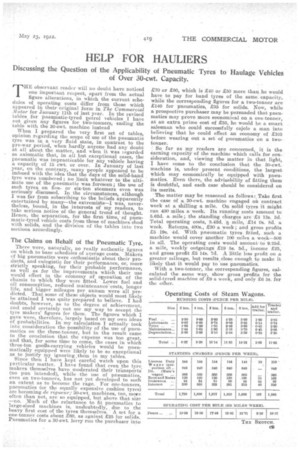HELP FOR HAULIERS
Page 9

If you've noticed an error in this article please click here to report it so we can fix it.
Discussing the Question of the Applicability of Pneumatic Tyres to Haulage Vehicles of Over 30-cwt. Capacity.
THE observant reader will no doubt have noticed one important respect, apart from the actual figure alterations, in which the current schedules of operating costs differ from those which appeared in their original form in The Commercial Motor for January 11th of last year. In the revised tables for pneumatic-tyred petrel vehicles I have not given any figures for two-tonners, ending the table with the 30-owt. machine instead When I prepared the very first set of tables, opinion rGgarding the scope of use of the pneumatic tyre was in a very fluid state, in contrast to the pre-war period, when hardly anyone had any doubt at all about the matter, and when it was iegarded as axiomatic that, in all but exceptional cases, the pneumatic was impracticable for any vehicle having a capacity of 15 cwt. or over. In January of last year, on the contrary, many people appeared to be imbued with the idea that the days of the solid-band . tyre were numbered; no limit whatever to the ultimate use of the pneumatic was foreseen; the use of such tyres on fiveor six-ton steamers even was seriously discussed. In the circumstances, although I was far from subscribing to the beliefs apparently entertained by many-the extremists--I was, nevertheless, bound., in the interests of my readers, to take serious notice of the general trend of thought. Hence, the separation, for the first time, of pneumatic-tyred vehicle costs from those of machines shod with solids, and the division of the tables into two sections accordingly.
The Claims on Behalf of the Pneumatic Tyre. There were, naturally, no really authentic figures on which to base schedules of average costs. Makers of big pneumatics were enthusiastic about their products, and eulogistic for their performance, or, more strictly speaking, for their probable performance, as well as for the improvements which their use would effect in the economy of operation of the chassis to which they were fitted, Lower fuel and oil consumption, reduced maintenance costs, longer life and bigger mileages per annum were all predicied. That some of these objects would most likely. be attained I was quite prepared to believe. I had doubts, however, as to the degree of achievement, and could certainly not see my way to accept the tyre makers' figures for them. The figures which I gave were, therefore, largely based on my own ideas of probabilities. In my calculation I actually took into consideration the possibility of the use of pneumatics on the three-tonner, but in the result came to the conclusion that the expense was too great, and that for some time to come, the cases in whichthree-ton gooas-carrying vehicles would be pneumatically equipped were likely to be so exceptional as to justify my ignoring ,them in my tables. Since then I have kept careful watch upon this particular matter. I have found that even the tyre makers themselves have moderated their transports (no pun intended), while the use of pneumatics, even on two-tonners, has not yet developed to such an extent as to become the rage. For one-tonners, pneumatics (or the equally expensive cushion tyres) are becoming de rigueur; 30-cwt. machines, too, more often than not, are so equipped, but above that size -no. Much of the reluctance to fit pneumatics to large-sized machines is, undoubtedly, due to the heavy first cost of the tyres themselves. ' A set for a oneetOriner costs about t 60, as against 225 for solids. Pneumatics for a 30-cwt. lorry ruiethe purchaser into £70 or 180, which is 240 or 250 more than he would have to pay for band tyres of the same_ capacity, while the corresponding figures for a two-tonner are 2140 for pneumatics, 235 for solids. Now, while a prospective purchaser may be persuaded that pneumatics may prove more economical on a oee-tonner, at an extra prime cost of 235, he would be a smart salesman who could successfully cajole a man into believing that he could effect an economy of 2105 before wearing out a set of pneumatics on a twotonner.
So far as my readers are concerned, it is the earning capacity of the machine which calls for consideration, and, viewing the matter in that light, I have come to the conclusion that the 30-cwt. machine is, under present conditions, the largest which may economically be equipped with pneumatics. Even there, the advisability of fitting them is doubtful, and each case should be considered on its merits.
• The matter may be reasoned as follows:. Take first the case of a 30-cwt. machine engaged on contract work at a shilling a mile. On solid tyres it might run 400 miles a -week, Its running costs amount to 5.62d. a mile ; the standing charges are -24 13s. 3d. Total operating costs, 8.42d. "a mile, £14 Os. 8d. a week. Returns, 400s., 220 a week; and gross profits 25 19s. 4d. With pneumatic tyres fitted, such a machine would cover another 100 miles a week-500 in all. The operating coats would amount to 9.25d. a mile, weekly outgoings .219 5s. 5c1., income 225, and gross profit 25 14s. 7d. A little less profit on a greater mileage, but results close enough to make it likely that it would pay to use pneumatics. With a two-tonner, the corresponding figures, calculated the same way, show gross profits for the solid-tyred machine of 29 a week, and only £6 58. for the other.






























